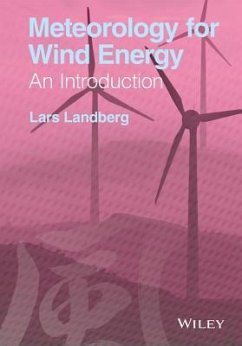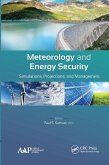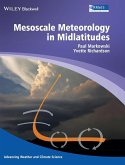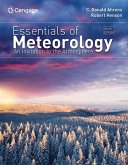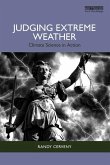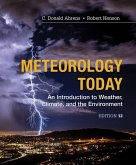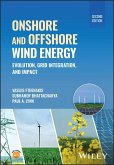- Gebundenes Buch
- Merkliste
- Auf die Merkliste
- Bewerten Bewerten
- Teilen
- Produkt teilen
- Produkterinnerung
- Produkterinnerung
Most practitioners within wind energy have only a very basic knowledge about meteorology, leading to a lack of understanding of one of the most fundamental subjects in wind energy. This book will therefore provide an easy-to-understand introduction to the subject of meteorology, as seen from the viewpoint of wind energy.
Andere Kunden interessierten sich auch für
![Meteorology and Energy Security Meteorology and Energy Security]() Meteorology and Energy Security87,99 €
Meteorology and Energy Security87,99 €![Mesoscale Meteorology in Midlatitudes Mesoscale Meteorology in Midlatitudes]() Paul Markowski (Penn State University)Mesoscale Meteorology in Midlatitudes93,99 €
Paul Markowski (Penn State University)Mesoscale Meteorology in Midlatitudes93,99 €![Heaven's Breath Heaven's Breath]() Lyall WatsonHeaven's Breath25,99 €
Lyall WatsonHeaven's Breath25,99 €![Essentials of Meteorology Essentials of Meteorology]() C. Donald Ahrens (Modesto Junior College)Essentials of Meteorology179,99 €
C. Donald Ahrens (Modesto Junior College)Essentials of Meteorology179,99 €![Judging Extreme Weather Judging Extreme Weather]() Randy CervenyJudging Extreme Weather47,99 €
Randy CervenyJudging Extreme Weather47,99 €![Meteorology Today: An Introduction to Weather, Climate and the Environment Meteorology Today: An Introduction to Weather, Climate and the Environment]() C. Donald Ahrens (Modesto Junior College)Meteorology Today: An Introduction to Weather, Climate and the Environment173,99 €
C. Donald Ahrens (Modesto Junior College)Meteorology Today: An Introduction to Weather, Climate and the Environment173,99 €![Onshore and Offshore Wind Energy Onshore and Offshore Wind Energy]() Vasilis M. Fthenakis (US Columbia University)Onshore and Offshore Wind Energy145,99 €
Vasilis M. Fthenakis (US Columbia University)Onshore and Offshore Wind Energy145,99 €-
-
-
Most practitioners within wind energy have only a very basic knowledge about meteorology, leading to a lack of understanding of one of the most fundamental subjects in wind energy. This book will therefore provide an easy-to-understand introduction to the subject of meteorology, as seen from the viewpoint of wind energy.
Hinweis: Dieser Artikel kann nur an eine deutsche Lieferadresse ausgeliefert werden.
Hinweis: Dieser Artikel kann nur an eine deutsche Lieferadresse ausgeliefert werden.
Produktdetails
- Produktdetails
- Verlag: John Wiley & Sons Inc
- Seitenzahl: 224
- Erscheinungstermin: 14. Dezember 2015
- Englisch
- Abmessung: 251mm x 174mm x 22mm
- Gewicht: 534g
- ISBN-13: 9781118913444
- ISBN-10: 1118913442
- Artikelnr.: 42965227
- Herstellerkennzeichnung
- Libri GmbH
- Europaallee 1
- 36244 Bad Hersfeld
- gpsr@libri.de
- Verlag: John Wiley & Sons Inc
- Seitenzahl: 224
- Erscheinungstermin: 14. Dezember 2015
- Englisch
- Abmessung: 251mm x 174mm x 22mm
- Gewicht: 534g
- ISBN-13: 9781118913444
- ISBN-10: 1118913442
- Artikelnr.: 42965227
- Herstellerkennzeichnung
- Libri GmbH
- Europaallee 1
- 36244 Bad Hersfeld
- gpsr@libri.de
Lars Landberg, DNV GL (formerly Garrad Hassan), Copenhagen, Denmark Lars is one of the most renowned experts of wind resources and wind energy in the world, having worked in this area for over 24 years. He was Head of Wind Energy Department at Risoe National Laboratory (now Danish Technical University), Roskilde, Denmark. He has a PhD in Physics/Geophysics and has developed and was the primary force behind the industry standard wind flow model known as WASP (Wind Atlas Analysis and Application Program) in its formative and subsequent years of software development A passionate proponent of his subject, he has taught a course on 'Meteorology with Wind Energy in Mind' to mainly professional practitioners since 2007.
Dedication iii
Foreword ix
Preface xi
Acknowledgements xiii
List of Abbreviations xv
1 Introduction 1
2 Meteorological Basics 5
2.1 Why does the wind blow? 5
2.2 The vertical structure of the atmosphere 9
2.3 Atmospheric variables and forces 13
2.3.1 Atmospheric Variables 13
2.3.2 Atmospheric Forces 13
2.3.3 Force Balances and the Geostrophic Wind 16
2.4 Length and time scales of atmospheric flow 20
2.5 Larger-scale systems (aka Weather) 22
2.5.1 Mid-latitudinal cyclone (low-pressure system) 22
2.5.2 Anticyclones (high-pressure systems) 23
2.5.3 Hurricanes 27
2.5.4 Monsoons 27
2.5.5 Climatological circulations 28
2.6 Summary 33
2.7 Exercises 34
3 Measurements 37
3.1 Philosophy: what does it mean to measure? 37
3.2 What do we measure? 40
3.3 Measurement theory 42
3.3.1 Are we good to go? 48
3.4 Practice 49
3.4.1 Measuring 49
3.4.2 Cup anemometer 52
3.4.3 Wind Vane 54
3.4.4 Sonic Anemometer 55
3.4.5 Hot wire 57
3.4.6 Pitot tube 57
3.4.7 Thermometer 58
3.4.8 Barometer 59
3.4.9 Remote sensing 60
3.4.10 Ceilometer 67
3.4.11 Weather balloon or the Radiosonde 67
3.4.12 Satellite-borne instruments 68
3.5 Summary 71
3.6 Exercises 72
4 The Wind Profile 73
4.1 A hand-waving way of deriving the simple log profile 73
4.2 Working with the log profile 75
4.3 The power law 77
4.4 Averaging times and other dependencies 79
4.5 Two famous profiles 80
4.6 Zero-plane displacement 82
4.7 Internal Boundary Layers (IBL) 83
4.8 Stability 86
4.9 Monin-Obukhov Theory 90
4.10 Deviations with height 94
4.11 Connection with geostrophic drag law 95
4.12 Effect of orography, obstacles and thermal flows on the profile 96
4.13 Direction profile 96
4.14 Summary 97
4.15 Excercises 97
5 Local Flow 99
5.1 Local effects 100
5.2 Orographic forcing 100
5.2.1 Analytical models 101
5.2.2 Attached flow: Flow in simple terrain 104
5.2.3 Detached flow: Flow in complex terrain 107
5.2.4 More advanced models for flow in complex terrain 109
5.3 Roughness 111
5.4 Obstacles 113
5.5 Thermally-driven flows 116
5.5.1 Sea/land breezes 116
5.5.2 Ana-/katabatic winds 118
5.6 Effect of stability 120
5.7 Summary 120
5.8 Exercises 120
6 Turbulence 123
6.1 What generates turbulence? 125
6.2 Reynolds Decomposition and Averaging 125
6.3 Spectra 126
6.3.1 Understanding Fourier analysis and spectra, a poor man/woman's
approach 127
6.3.2 Standard types of spectra 131
6.4 Measuring Turbulence 135
6.5 Turbulent Loads 135
6.6 Extreme winds 137
6.7 Summary 137
6.8 Exercises 138
7 Wakes 139
7.1 Turbine-to-turbine wakes 140
7.1.1 The NO Jensen model 142
7.1.2 The Ainslie model 145
7.1.3 Similarity theory 147
7.1.4 Effect on power 149
7.1.5 Wake models, summary 152
7.2 Several wind turbines, i.e. a wind farm 153
7.3 Advanced topics 153
7.3.1 Measuring the wakes 153
7.3.2 Onshore/offshore wakes 155
7.3.3 Very large wind farms, state of the art 156
7.3.4 Wind farm to wind farm interaction 156
7.4 Summary 156
7.5 Exercises 157
8 Modelling 159
8.1 Modelling and what it means 159
8.2 Input 159
8.3 Modelling 160
8.3.1 NWP (Numerical Weather Prediction) models 163
8.3.2 Sub-grid processes 166
8.4 Output 167
8.5 Errors 168
8.6 So, what is a good model? 169
8.7 Chaos 170
8.7.1 Ensemble prediction 171
8.8 Summary 171
8.9 Exercises 173
9 Conclusion 175
References 177
A Cheat sheet 181
B Answers to Exercises 185
C Sample wind speed and direction data 203
Index 205
Foreword ix
Preface xi
Acknowledgements xiii
List of Abbreviations xv
1 Introduction 1
2 Meteorological Basics 5
2.1 Why does the wind blow? 5
2.2 The vertical structure of the atmosphere 9
2.3 Atmospheric variables and forces 13
2.3.1 Atmospheric Variables 13
2.3.2 Atmospheric Forces 13
2.3.3 Force Balances and the Geostrophic Wind 16
2.4 Length and time scales of atmospheric flow 20
2.5 Larger-scale systems (aka Weather) 22
2.5.1 Mid-latitudinal cyclone (low-pressure system) 22
2.5.2 Anticyclones (high-pressure systems) 23
2.5.3 Hurricanes 27
2.5.4 Monsoons 27
2.5.5 Climatological circulations 28
2.6 Summary 33
2.7 Exercises 34
3 Measurements 37
3.1 Philosophy: what does it mean to measure? 37
3.2 What do we measure? 40
3.3 Measurement theory 42
3.3.1 Are we good to go? 48
3.4 Practice 49
3.4.1 Measuring 49
3.4.2 Cup anemometer 52
3.4.3 Wind Vane 54
3.4.4 Sonic Anemometer 55
3.4.5 Hot wire 57
3.4.6 Pitot tube 57
3.4.7 Thermometer 58
3.4.8 Barometer 59
3.4.9 Remote sensing 60
3.4.10 Ceilometer 67
3.4.11 Weather balloon or the Radiosonde 67
3.4.12 Satellite-borne instruments 68
3.5 Summary 71
3.6 Exercises 72
4 The Wind Profile 73
4.1 A hand-waving way of deriving the simple log profile 73
4.2 Working with the log profile 75
4.3 The power law 77
4.4 Averaging times and other dependencies 79
4.5 Two famous profiles 80
4.6 Zero-plane displacement 82
4.7 Internal Boundary Layers (IBL) 83
4.8 Stability 86
4.9 Monin-Obukhov Theory 90
4.10 Deviations with height 94
4.11 Connection with geostrophic drag law 95
4.12 Effect of orography, obstacles and thermal flows on the profile 96
4.13 Direction profile 96
4.14 Summary 97
4.15 Excercises 97
5 Local Flow 99
5.1 Local effects 100
5.2 Orographic forcing 100
5.2.1 Analytical models 101
5.2.2 Attached flow: Flow in simple terrain 104
5.2.3 Detached flow: Flow in complex terrain 107
5.2.4 More advanced models for flow in complex terrain 109
5.3 Roughness 111
5.4 Obstacles 113
5.5 Thermally-driven flows 116
5.5.1 Sea/land breezes 116
5.5.2 Ana-/katabatic winds 118
5.6 Effect of stability 120
5.7 Summary 120
5.8 Exercises 120
6 Turbulence 123
6.1 What generates turbulence? 125
6.2 Reynolds Decomposition and Averaging 125
6.3 Spectra 126
6.3.1 Understanding Fourier analysis and spectra, a poor man/woman's
approach 127
6.3.2 Standard types of spectra 131
6.4 Measuring Turbulence 135
6.5 Turbulent Loads 135
6.6 Extreme winds 137
6.7 Summary 137
6.8 Exercises 138
7 Wakes 139
7.1 Turbine-to-turbine wakes 140
7.1.1 The NO Jensen model 142
7.1.2 The Ainslie model 145
7.1.3 Similarity theory 147
7.1.4 Effect on power 149
7.1.5 Wake models, summary 152
7.2 Several wind turbines, i.e. a wind farm 153
7.3 Advanced topics 153
7.3.1 Measuring the wakes 153
7.3.2 Onshore/offshore wakes 155
7.3.3 Very large wind farms, state of the art 156
7.3.4 Wind farm to wind farm interaction 156
7.4 Summary 156
7.5 Exercises 157
8 Modelling 159
8.1 Modelling and what it means 159
8.2 Input 159
8.3 Modelling 160
8.3.1 NWP (Numerical Weather Prediction) models 163
8.3.2 Sub-grid processes 166
8.4 Output 167
8.5 Errors 168
8.6 So, what is a good model? 169
8.7 Chaos 170
8.7.1 Ensemble prediction 171
8.8 Summary 171
8.9 Exercises 173
9 Conclusion 175
References 177
A Cheat sheet 181
B Answers to Exercises 185
C Sample wind speed and direction data 203
Index 205
Dedication iii
Foreword ix
Preface xi
Acknowledgements xiii
List of Abbreviations xv
1 Introduction 1
2 Meteorological Basics 5
2.1 Why does the wind blow? 5
2.2 The vertical structure of the atmosphere 9
2.3 Atmospheric variables and forces 13
2.3.1 Atmospheric Variables 13
2.3.2 Atmospheric Forces 13
2.3.3 Force Balances and the Geostrophic Wind 16
2.4 Length and time scales of atmospheric flow 20
2.5 Larger-scale systems (aka Weather) 22
2.5.1 Mid-latitudinal cyclone (low-pressure system) 22
2.5.2 Anticyclones (high-pressure systems) 23
2.5.3 Hurricanes 27
2.5.4 Monsoons 27
2.5.5 Climatological circulations 28
2.6 Summary 33
2.7 Exercises 34
3 Measurements 37
3.1 Philosophy: what does it mean to measure? 37
3.2 What do we measure? 40
3.3 Measurement theory 42
3.3.1 Are we good to go? 48
3.4 Practice 49
3.4.1 Measuring 49
3.4.2 Cup anemometer 52
3.4.3 Wind Vane 54
3.4.4 Sonic Anemometer 55
3.4.5 Hot wire 57
3.4.6 Pitot tube 57
3.4.7 Thermometer 58
3.4.8 Barometer 59
3.4.9 Remote sensing 60
3.4.10 Ceilometer 67
3.4.11 Weather balloon or the Radiosonde 67
3.4.12 Satellite-borne instruments 68
3.5 Summary 71
3.6 Exercises 72
4 The Wind Profile 73
4.1 A hand-waving way of deriving the simple log profile 73
4.2 Working with the log profile 75
4.3 The power law 77
4.4 Averaging times and other dependencies 79
4.5 Two famous profiles 80
4.6 Zero-plane displacement 82
4.7 Internal Boundary Layers (IBL) 83
4.8 Stability 86
4.9 Monin-Obukhov Theory 90
4.10 Deviations with height 94
4.11 Connection with geostrophic drag law 95
4.12 Effect of orography, obstacles and thermal flows on the profile 96
4.13 Direction profile 96
4.14 Summary 97
4.15 Excercises 97
5 Local Flow 99
5.1 Local effects 100
5.2 Orographic forcing 100
5.2.1 Analytical models 101
5.2.2 Attached flow: Flow in simple terrain 104
5.2.3 Detached flow: Flow in complex terrain 107
5.2.4 More advanced models for flow in complex terrain 109
5.3 Roughness 111
5.4 Obstacles 113
5.5 Thermally-driven flows 116
5.5.1 Sea/land breezes 116
5.5.2 Ana-/katabatic winds 118
5.6 Effect of stability 120
5.7 Summary 120
5.8 Exercises 120
6 Turbulence 123
6.1 What generates turbulence? 125
6.2 Reynolds Decomposition and Averaging 125
6.3 Spectra 126
6.3.1 Understanding Fourier analysis and spectra, a poor man/woman's
approach 127
6.3.2 Standard types of spectra 131
6.4 Measuring Turbulence 135
6.5 Turbulent Loads 135
6.6 Extreme winds 137
6.7 Summary 137
6.8 Exercises 138
7 Wakes 139
7.1 Turbine-to-turbine wakes 140
7.1.1 The NO Jensen model 142
7.1.2 The Ainslie model 145
7.1.3 Similarity theory 147
7.1.4 Effect on power 149
7.1.5 Wake models, summary 152
7.2 Several wind turbines, i.e. a wind farm 153
7.3 Advanced topics 153
7.3.1 Measuring the wakes 153
7.3.2 Onshore/offshore wakes 155
7.3.3 Very large wind farms, state of the art 156
7.3.4 Wind farm to wind farm interaction 156
7.4 Summary 156
7.5 Exercises 157
8 Modelling 159
8.1 Modelling and what it means 159
8.2 Input 159
8.3 Modelling 160
8.3.1 NWP (Numerical Weather Prediction) models 163
8.3.2 Sub-grid processes 166
8.4 Output 167
8.5 Errors 168
8.6 So, what is a good model? 169
8.7 Chaos 170
8.7.1 Ensemble prediction 171
8.8 Summary 171
8.9 Exercises 173
9 Conclusion 175
References 177
A Cheat sheet 181
B Answers to Exercises 185
C Sample wind speed and direction data 203
Index 205
Foreword ix
Preface xi
Acknowledgements xiii
List of Abbreviations xv
1 Introduction 1
2 Meteorological Basics 5
2.1 Why does the wind blow? 5
2.2 The vertical structure of the atmosphere 9
2.3 Atmospheric variables and forces 13
2.3.1 Atmospheric Variables 13
2.3.2 Atmospheric Forces 13
2.3.3 Force Balances and the Geostrophic Wind 16
2.4 Length and time scales of atmospheric flow 20
2.5 Larger-scale systems (aka Weather) 22
2.5.1 Mid-latitudinal cyclone (low-pressure system) 22
2.5.2 Anticyclones (high-pressure systems) 23
2.5.3 Hurricanes 27
2.5.4 Monsoons 27
2.5.5 Climatological circulations 28
2.6 Summary 33
2.7 Exercises 34
3 Measurements 37
3.1 Philosophy: what does it mean to measure? 37
3.2 What do we measure? 40
3.3 Measurement theory 42
3.3.1 Are we good to go? 48
3.4 Practice 49
3.4.1 Measuring 49
3.4.2 Cup anemometer 52
3.4.3 Wind Vane 54
3.4.4 Sonic Anemometer 55
3.4.5 Hot wire 57
3.4.6 Pitot tube 57
3.4.7 Thermometer 58
3.4.8 Barometer 59
3.4.9 Remote sensing 60
3.4.10 Ceilometer 67
3.4.11 Weather balloon or the Radiosonde 67
3.4.12 Satellite-borne instruments 68
3.5 Summary 71
3.6 Exercises 72
4 The Wind Profile 73
4.1 A hand-waving way of deriving the simple log profile 73
4.2 Working with the log profile 75
4.3 The power law 77
4.4 Averaging times and other dependencies 79
4.5 Two famous profiles 80
4.6 Zero-plane displacement 82
4.7 Internal Boundary Layers (IBL) 83
4.8 Stability 86
4.9 Monin-Obukhov Theory 90
4.10 Deviations with height 94
4.11 Connection with geostrophic drag law 95
4.12 Effect of orography, obstacles and thermal flows on the profile 96
4.13 Direction profile 96
4.14 Summary 97
4.15 Excercises 97
5 Local Flow 99
5.1 Local effects 100
5.2 Orographic forcing 100
5.2.1 Analytical models 101
5.2.2 Attached flow: Flow in simple terrain 104
5.2.3 Detached flow: Flow in complex terrain 107
5.2.4 More advanced models for flow in complex terrain 109
5.3 Roughness 111
5.4 Obstacles 113
5.5 Thermally-driven flows 116
5.5.1 Sea/land breezes 116
5.5.2 Ana-/katabatic winds 118
5.6 Effect of stability 120
5.7 Summary 120
5.8 Exercises 120
6 Turbulence 123
6.1 What generates turbulence? 125
6.2 Reynolds Decomposition and Averaging 125
6.3 Spectra 126
6.3.1 Understanding Fourier analysis and spectra, a poor man/woman's
approach 127
6.3.2 Standard types of spectra 131
6.4 Measuring Turbulence 135
6.5 Turbulent Loads 135
6.6 Extreme winds 137
6.7 Summary 137
6.8 Exercises 138
7 Wakes 139
7.1 Turbine-to-turbine wakes 140
7.1.1 The NO Jensen model 142
7.1.2 The Ainslie model 145
7.1.3 Similarity theory 147
7.1.4 Effect on power 149
7.1.5 Wake models, summary 152
7.2 Several wind turbines, i.e. a wind farm 153
7.3 Advanced topics 153
7.3.1 Measuring the wakes 153
7.3.2 Onshore/offshore wakes 155
7.3.3 Very large wind farms, state of the art 156
7.3.4 Wind farm to wind farm interaction 156
7.4 Summary 156
7.5 Exercises 157
8 Modelling 159
8.1 Modelling and what it means 159
8.2 Input 159
8.3 Modelling 160
8.3.1 NWP (Numerical Weather Prediction) models 163
8.3.2 Sub-grid processes 166
8.4 Output 167
8.5 Errors 168
8.6 So, what is a good model? 169
8.7 Chaos 170
8.7.1 Ensemble prediction 171
8.8 Summary 171
8.9 Exercises 173
9 Conclusion 175
References 177
A Cheat sheet 181
B Answers to Exercises 185
C Sample wind speed and direction data 203
Index 205

